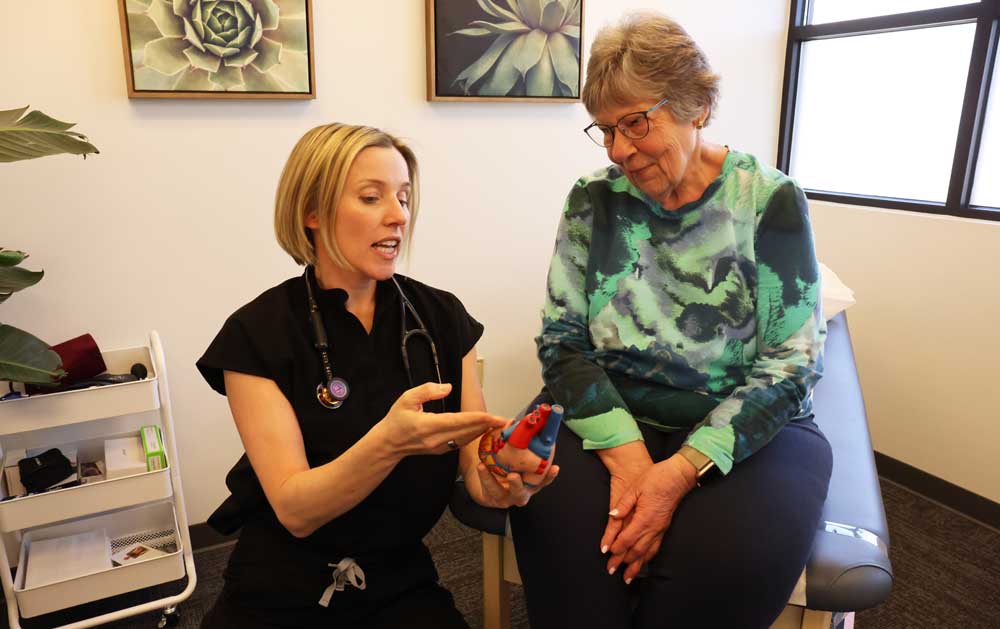Unparalleled access: Patients pay monthly fee for doctor who delivers unfettered care
Published 5:45 am Sunday, May 12, 2024

- Dr. Sarah Dawson explains the anatomy of a heart to Peggy Neal during an office visit at IM Well Internal Medicine and Wellness in Bend.
When patients call Dr. Sarah Dawson, they’ll likely get her the first time they try.
There’s no waiting on hold, or getting lost in a phone tree. Just a doctor available the same day a patient calls for an appointment.
Trending
Dawson is practicing what is called direct primary care, a growing trend in medicine where the patient bypasses insurance and pays a subscription to the doctor for unfettered access. There’s no insurance referrals to obtain, no claim forms to process. The monthly or annual membership fee, paid by the patient or an employer, allows for patients to reach a doctor for most health issues, including lab work.
When Dawson worked at St. Charles Health System as an internal medicine physician she had more than 1,700 patients assigned to her and saw as many as 18 patients a day and answered questions from patients online. As a direct primary care physician she has 70 to 150 patients.
“It was really stressful to make people feel comfortable in 20 to 40 minutes,” Dawson said. “We’re getting out of the fee for service and we can keep our patient population very small. People want to get out of the factory medicine.
“I can’t do a good job with a patient in 10 or 15 minutes. I need more time.”
One way to deliver health care
The model offers patients direct access to their physician and addresses physician burnout, said John McConnell, Oregon Health and Science University health economist. COVID-19 sped up the process of a nursing and physician shortage, which in turn sped up the process of more patients and fewer medical personnel.
Trending
“Burnout is real, especially in the primary care setting,” McConnell said. “It’s something we have to take seriously. We’d like everyone to have job satisfaction and the direct primary care model is one way to address that.”
The access is great for those who can afford to pay, but it does create a two tier system: those who can afford it and those who cannot and must stick with the traditional fee-for-service model, McConnell said. And the more physicians that go this way, means fewer in the traditional delivery of medical services, which increases the wait times and access to quality care, McConnell said.
“The ethical concern is the role of the physicians prioritization of patients and their ability to pay,” he said. “There’s an assumption that health care should be available to all.”
Dawson charges $499 a month, and for patients older than 65, it’s $399 a month. Patients are given an hour a visit with the physician and Dawson often will answer the office phone personally.
“Patients are super happy,” Dawson said. “We tried to pick a price point that was doable. Many of the patients are people who came here and want to ski and retired well. Other patients are not wealthy, but have a medical condition and ongoing medical needs.”
Even when Dawson was practicing at St. Charles, Scott Wilson felt he was her only patient. That’s why he followed Dawson when she set up he direct primary care practice.
At 72 years old, Wilson is an avid mountain biker who is on his bike every day. He wants it to stay that way.
“She knows my personality and she knows what I like to do and she helps me do it,” Wilson said. “This is the thing I appreciate about her. She is the best primary care physician I’ve ever had.
Fee for services
According to the American Academy of Family Physicians, the direct primary care model gives physicians more control over their patient loads. Patients pay a monthly, or annual fee that generally covers primary care services, laboratory, consulting and care coordination.
Typically, a direct care medical practice has about 400 patients. Most of those patients received services for electrocardiograms, biopsies and excisions and cyro-surgery, according to a 2022 survey of direct primary care patients in 2022 by the academy.
“These types of models have been around for a long time, “ said Peter McGarry, PacificSource vice president of provider network. “Some of these models provide extraordinary care. Some will come to your home or see you wherever you are.
“You can have expensive, customized care in your own living room.”
Hospital systems recognize that depending on the community needs, direct primary care can serve a purpose.
“Primary care capacity in Central Oregon and nationally is challenged to meet the demand,” said Alandra Johnson, St. Charles Health System spokeswoman. “We understand that demand can be met in different ways on the needs and desires of the community.”
St. Charles Internal Medicine staff dwindling
When Dawson started working at St. Charles she was supposed to work with a second internist in the Internal Medicine department. She wound up alone in the department and the health system leadership tried to steer her toward family practice, which was rough, she said, as a new graduate.
Two years later she was moved from the east Bend clinic on Neff Road to a separate Internal Medicine clinic with two other physicians. That lasted until 2021 when internal medicine was moved to family medicine. Dawson left St. Charles in 2023 to start her own practice.
Internal medicine typically sees more older patients with managed diseases, compared to family practice with sees patients of all ages.
“We weren’t well staffed, but we were successful and made money,” Dawson said. “After eight years, I resigned.”
Today, St. Charles’s two remaining internal medicine physicians will be ending their practice with the health system by June, leaving no internal medicine physicians working with primary care, Johnson said.
“St. Charles continues to employ numerous internal medicine physicians in areas outside of primary care,” Johnson said. “St. Charles also attracts many medical providers to serve Central Oregonians, with 60 providers hired in 2023 and a similar number expected for 2024.”
A comprehensive model
Direct primary care is not a new model for medical service, said Divya Sharma, Central Oregon Independent Practice Association, a regional health care consultant. Primary care physicians have a demanding job of meeting patient expectations and reporting regulations, Sharma said.
“It’s because of burn out and exhaustion,” Sharma said. “Providers are expected to spend time with the patients but are not given the time. The reimbursement model is upside down because to make revenue work they have to see a lot more patients.”
Related coverage: Nurses assaulted by patients called an ‘under-reported epidemic’
If too many physicians set up direct primary care practices there are not enough practicing in the traditional fee-for-service model and the wait times will increase, she said.
When Mike Osborn, a patient of Dawson’s, needs to see her, he can get an appointment within days, not weeks or months. And the appointment itself isn’t rushed, he said.
“She has a common, whole man approach to medicine,” said Osborn, 77. “I succumbed to her insistence that I do something about my high blood pressure and we spent an hour on what the pros and cons were for treatment. The monthly cost is a bargain for the whole man care that she applies.”








